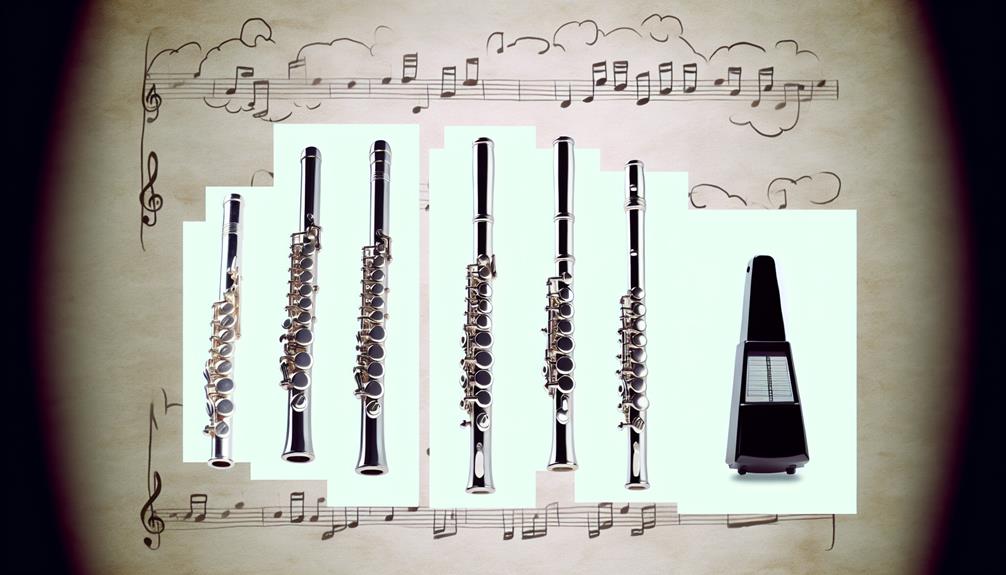Exploring the domain of scales and arpeggios in the context of flute playing reveals a world of technical discipline and artistic refinement. These foundational exercises serve as the cornerstone for honing essential skills and deepening musical understanding. As flutists investigate the intricacies of these foundational elements, a journey of discovery unfolds, offering insights into the interconnectedness of technique, tone production, and musical expression. The mastery of scales and arpeggios not only nurtures precision and agility but also establishes the groundwork for fully realizing the flute's melodic capabilities.
Key Takeaways
- Scales and arpeggios enhance finger dexterity and breath control.
- Practice with a metronome for timing and speed control.
- Focus on tone quality, dynamics, and varied articulation techniques.
- Track progress using a practice journal and seek feedback.
- Importance lies in technical proficiency, musical understanding, and fluency development.
Introduction
The introduction sets the stage for understanding the significance of incorporating scales and arpeggios into flute practice. By providing an overview of the benefits derived from regular technical exercises, musicians can enhance both their technical proficiency and musical expression.
This discussion lays the foundation for exploring how scales and arpeggios contribute to a flutist's overall growth and development.
Overview of the importance of scales and arpeggios
In the domain of musical proficiency, mastery of scales and arpeggios serves as a fundamental cornerstone for technical prowess and expressive depth. Practicing scales and arpeggios on the flute offers a myriad of benefits for musicians. It enhances finger dexterity, breath control, intonation, and overall fluency. These fundamental exercises lay the groundwork for mastering complex musical pieces by improving muscle memory and coordination. Additionally, scales and arpeggios aid in developing a deep understanding of key signatures and intervals, essential for musical interpretation and improvisation.
| Benefits of Scales and Arpeggios | Techniques | Progress Tracking |
|---|---|---|
| Enhances finger dexterity | Use of metronome for timing and speed control | Keep a practice journal to monitor improvement |
| Improves breath control | Focus on tone quality and dynamics | Record practice sessions for self-assessment |
| Enhances intonation | Utilize varied articulation techniques | Set specific goals for each practice session |
| Improves overall fluency | Practice scales in different rhythmic patterns | Seek feedback from teachers or peers for evaluation |
Benefits of regular practice for technical and musical development
Practicing scales and arpeggios consistently lays a fundamental foundation for both technical proficiency and musical expressiveness on the flute. The regularity of practice not only hones technical skills but also nurtures musicality, enabling a flutist to convey emotions and connect with the audience effectively.
While technical exercises focus on precision and agility, musical expression demands sensitivity and artistry. Balancing these aspects is vital for a well-rounded performance. By engaging in regular scale and arpeggio practice, musicians can develop a seamless blend of technique and expression, enhancing their overall playing style.
Additionally, consistent practice aids in achieving a balance between speed and accuracy. Through dedicated repetition and attention to detail, flutists can master challenging passages with fluency and confidence. This disciplined approach to practice cultivates a deep understanding of the instrument, allowing performers to transcend technical limitations and deliver engaging musical interpretations.
Essentially, the benefits of regular scale and arpeggio practice extend beyond technical proficiency, shaping a flutist's musical identity and artistry.
Importance of Practicing Scales and Arpeggios
Practicing scales and arpeggios on the flute is essential for developing technical proficiency by honing finger dexterity, breath control, and overall coordination.
Moreover, these exercises help musicians enhance their understanding of music theory, such as key signatures, intervals, and chord structures.
Building Technical Proficiency
Developing technical proficiency on the flute is essential for any serious musician.
Scales and arpeggios play an important role in enhancing finger dexterity and promoting breath control and support.
How scales and arpeggios improve finger dexterity
Enhancing technical proficiency in playing the flute can be greatly advanced through consistent practice of scales and arpeggios. These fundamental exercises promote finger flexibility essential for mastering intricate musical passages.
Developing breath control and support
The cultivation of precise breath control and support is paramount in the pursuit of technical proficiency for flute players. This skill can be skillfully honed through the diligent practice of scales and arpeggios.
- Breath control exercises, musical expression
- Long tone practice, dynamic range
- Diaphragm support, phrasing techniques
Enhancing Musical Understanding
Practicing scales and arpeggios is essential for enhancing musical understanding as it allows musicians to grasp key signatures and tonal relationships more profoundly. This understanding can then be applied in various musical contexts, such as sight-reading and improvisation, enabling musicians to navigate pieces more effectively and expressively.
Understanding key signatures and tonal relationships
Key signatures in music notation serve as fundamental indicators of the tonal relationships within a piece. They provide essential insights into the harmonic structure and guide the interpretation of musical phrases.
- Tonal relationships exploration
- Key signature analysis
- Understanding musical structure
Application in sight-reading and improvisation
Enhancing musical understanding through the consistent application of scales and arpeggios is a cornerstone of effective sight-reading and improvisation techniques in flute performance. Mastery of these fundamental elements not only fosters technical precision but also enables creative exploration and enhances musical expression.
Foundation for Repertoire
Practicing scales and arpeggios on the flute is essential to building a strong foundation for tackling intricate repertoire pieces.
These exercises play a vital role in developing technical skills, improving finger dexterity, and enhancing overall musical fluency.
Role of scales and arpeggios in flute literature
The systematic integration of scales and arpeggios within flute practice serves as a fundamental cornerstone for developing technical proficiency and interpretive depth in the vast landscape of flute literature.
- Enhances flute techniques
- Improves musical fluency
- Refines performance skills
Preparing for more complex pieces and passages
Effective mastery of flute scales and arpeggios lays a solid foundation essential for tackling the intricacies of more complex musical pieces and passages.
By honing technical fluency through scales, flutists can navigate challenging passages with ease.
This technical proficiency then opens the door for artistic interpretation and musical expression, allowing performers to convey the emotional depth and complexity of the repertoire with precision and nuance.
Major and Minor Scales
The distinction between major and minor scales lies in their unique patterns of intervals, creating distinct tonal qualities. Major scales are often associated with a bright, uplifting sound, while minor scales tend to evoke feelings of melancholy or introspection.
Understanding and mastering both major and minor scales is essential for developing fluency and versatility in flute playing.
Introduction to Major Scales
Major scales are foundational in music theory, consisting of a specific pattern of whole and half steps. Understanding the structure of major scales is pivotal for mastering music theory and performance.
Practicing all 12 major scales is essential for developing fluency and versatility in playing the flute.
Structure of major scales (whole and half steps)
Understanding the underlying structure of major scales involves grasping the arrangement of whole and half steps within the scale.
- Scale patterns: Major scales follow a specific pattern of whole and half steps to create a distinct sound.
- Interval structure: The intervals between each note in a major scale are consistent, giving it a unique harmonic quality.
- Finger technique: Proper finger placement is vital to navigate the whole and half steps accurately while playing major scales on the flute.
Importance of practicing all 12 major scales
Exploring all 12 major scales on the flute offers a thorough foundation for developing technical proficiency and musical versatility.
Scale variations and practice routines enhance fluency across different tonalities, preparing flutists for diverse musical applications and performance benefits.
Engaging with the technical challenges presented by each scale fosters skill progression, enabling musicians to navigate complex musical passages with ease and precision.
Regular practice of all major scales is essential for a well-rounded flute player.
Practicing Major Scales
In practicing major scales on the flute, it is important to focus on mastering the fingerings for each scale to guarantee accuracy and fluency. Smooth shifts between notes can be achieved by incorporating tips such as proper breath control and efficient finger movements.
Additionally, exercises that target tone production and intonation are essential for developing a consistent sound quality across all major scales.
Fingerings for each major scale
Utilizing the correct fingerings for each major scale is essential for developing technical proficiency and fluency on the flute. When considering scale variations, fingering techniques, and musical applications, it becomes evident that mastering these nuances is pivotal for a well-rounded performance. The correct fingerings allow for smooth and efficient shifts between notes, enhancing the overall clarity and precision of the music produced.
- Scale variations
- Fingering techniques
- Musical applications
Tips for smooth transitions between notes
Mastering the art of seamlessly connecting individual notes within Major and Minor Scales, particularly when practicing Major Scales, is a fundamental aspect of achieving technical proficiency and musical fluidity on the flute.
To guarantee smooth playing, flutists can focus on note connection, employ progression techniques, and utilize fingering tips. These strategies enhance musical flow, resulting in a seamless performance that captivates listeners.
Exercises for even tone and intonation
Achieving a consistent and balanced tone while maintaining precise intonation is important when practicing Major Scales on the flute to enhance overall musical performance.
- Tone exercises and intonation drills are necessary for developing a smooth sound.
- Flute technique and musicality training play an essential role in achieving a refined tone quality.
- Precision practice and breath control techniques are required for mastering the nuances of Major Scales.
Introduction to Minor Scales
The minor scales, comprising natural, harmonic, and melodic variations, are fundamental elements in music theory that offer distinct tonal qualities and emotional expressions.
Understanding the structures of these minor scales is essential for musicians seeking to broaden their repertoire and interpret compositions accurately.
Recognizing the differences between natural, harmonic, and melodic minor scales equips flutists with the knowledge to navigate the nuanced tonalities of various musical pieces.
Structure of natural, harmonic, and melodic minor scales
A fundamental aspect of music theory involves understanding the distinct structures of natural, harmonic, and melodic minor scales within the context of major and minor scales.
- Structure analysis: Natural minor scales follow the pattern of whole steps and half steps specific to minor scales.
- Scale variations: Harmonic minor scales raise the seventh degree to create a more pronounced leading tone.
- Practical applications: Melodic minor scales are commonly used in classical music to create smooth and expressive melodies.
Differences between the three minor scales
Analyzing the distinct characteristics of natural, harmonic, and melodic minor scales reveals essential differences in their structure and tonal qualities.
The melodic vs harmonic minor scales showcase variations in the ascending and descending forms, impacting the intervals and tonality.
Additionally, the natural vs chromatic minor scales differ in the presence of raised leading tones, influencing the overall sound and emotional quality of the scale.
Understanding these minor scale variations is vital for mastering musical fluency.
Practicing Minor Scales
Practicing minor scales on the flute entails mastering specific fingerings for each scale. It also involves honing techniques to navigate the variations in these scales and engaging in exercises that promote consistent sound production and accuracy.
By focusing on the nuances of minor scales, flutists can enhance their technical proficiency and musical expression. This ultimately elevates their performance capabilities.
Through dedicated practice and attention to detail, flutists can cultivate a thorough understanding and command of minor scales. This enriches their musical repertoire and fluency on the instrument.
Fingerings for each minor scale
Exploring the various fingerings for each minor scale in the context of practicing major and minor scales provides a thorough understanding of the technical aspects involved in flute performance.
- Alternate fingerings
- Minor scale variations
- Technical challenges
Techniques for mastering the variations
After familiarizing oneself with the fingerings for each minor scale, the focus shifts towards implementing specific techniques that aid in mastering the variations when practicing major and minor scales on the flute. Fingering techniques and breath control are essential for seamless shifts between notes.
Musical interpretation and tone quality enhance expressiveness. Rhythmic precision and dynamic contrast bring life to the scales, creating a well-rounded practice routine.
Exercises for consistent sound and accuracy
Implementing consistent sound and accuracy in flute playing, especially when practicing minor scales, requires a meticulous approach to fingering precision and breath control. To enhance sound quality and consistency, flutists can focus on proper embouchure and airflow management.
Developing accuracy and precision involves practicing intonation control and finger placement. Technique improvement and fluency can be achieved through regular scales practice with attention to articulation and dynamics.
Chromatic Scales
Chromatic scales introduce all twelve tones within an octave, incorporating both natural and altered notes. Understanding the structure and fingerings of chromatic scales is essential for flute players to navigate through complex musical passages with precision.
Regular practice of chromatic scales enhances a flutist's intonation, finger dexterity, and overall technical proficiency.
Introduction to Chromatic Scales
The chromatic scale, consisting of all twelve pitches in an octave played in succession, is a fundamental concept in music theory.
Comprised exclusively of half steps, this scale provides a thorough view of all available pitch possibilities within an octave.
Understanding and mastering chromatic scales is essential for developing technical proficiency and dexterity on the flute, as they require precision and control over fingering and breath support.
Structure of the chromatic scale (half steps)
Exploring the structure of the chromatic scale involves dissecting the sequence of half steps that delineate the scale's unique arrangement of notes.
Chromatic scale variations: Understanding the different ways in which chromatic scales can be modified or utilized in musical compositions.
Half steps significance: Recognizing the importance of half steps in creating the chromatic scale's distinct sound and character.
Chromatic scale exploration: Delving into the full range and possibilities offered by the chromatic scale in musical contexts.
Importance of chromatic scales in technique development
Understanding the intricate relationship between chromatic scales and technical precision is fundamental in enhancing a musician's overall skill set.
Chromatic scales challenge flutists to navigate each half-step with accuracy, fostering technical precision. Additionally, mastering chromatic scales allows for greater musical expression through smooth progressions between notes.
This precision opens avenues for artistic interpretation, enabling musicians to convey emotions and nuances effectively in their performances.
Practicing Chromatic Scales
When approaching the practice of chromatic scales on the flute, it is essential to focus on mastering the intricate fingerings required for seamless execution.
Incorporating exercises that target fluidity and speed can aid in developing a more agile and controlled technique.
Additionally, maintaining evenness and clarity throughout the chromatic scale is vital for achieving a polished and professional sound.
Fingerings for the chromatic scale
For mastering the chromatic scale on the flute, understanding the specific fingerings is essential for precision and fluidity in performance.
- Alternative fingerings, practice routines
- Advanced chromatic techniques, performance challenges
- Finger flexibility, tone production.
Exercises for fluidity and speed
To enhance fluidity and speed in flute playing, incorporating specific exercises focused on practicing chromatic scales is crucial for technical proficiency and musical dexterity.
Speed exercises and advanced techniques aid in developing agility, while addressing articulation challenges and implementing rhythmic variations enhances precision.
Additionally, a focus on musicality through expression techniques guarantees a well-rounded approach to mastering chromatic scales for a more dynamic and engaging performance.
Tips for maintaining evenness and clarity
Maintaining evenness and clarity in flute playing while practicing chromatic scales requires meticulous attention to finger placement, breath control, and consistency in articulation.
- Finger placement
- Articulation techniques
- Dynamic control
Arpeggio Exercises for Beginners and Advanced Players
Arpeggios, a fundamental element in music, are sequences of notes played in a chord one after the other.
For beginners, arpeggio exercises focus on mastering basic patterns and hand coordination, gradually advancing to more complex sequences for advanced players.
Understanding how arpeggios are used in different musical contexts is essential for developing a versatile and expressive flute playing style.
Introduction to Arpeggios
Arpeggios, fundamental to music theory, are broken chords played one note at a time in a sequence. Understanding the structure and function of arpeggios is essential for musicians of all levels, as they contribute to the harmonic richness of a piece and aid in developing technical proficiency.
In the domain of flute playing, mastering arpeggio exercises is vital for achieving fluidity and precision in performance.
Definition and structure of arpeggios
In music theory, arpeggios are defined as the sounding of the notes of a chord in a sequential fashion, rather than simultaneously, providing a distinct harmonic structure that is essential for understanding and mastering musical compositions.
- Arpeggio patterns, harmonic progressions
- Arpeggio technique, fluidity
- Arpeggio practice, musical expression
Role of arpeggios in music and technique
The significance of arpeggios in music and technique lies in their ability to intricately unravel the harmonic structure of chords, providing both beginners and advanced players with an essential foundation for musical expression and technical proficiency. Arpeggio variations enhance musical expression, artistic interpretation is enriched through arpeggio dynamics, and performance techniques are honed with arpeggio phrasing.
| Arpeggio Variations | Arpeggio Dynamics | Arpeggio Phrasing |
|---|---|---|
| Diverse patterns | Expressive shifts | Smooth progressions |
Arpeggio Exercises for Beginners
Within the domain of flute playing, mastering arpeggios is an essential skill that requires both precision and dexterity. Beginners can benefit greatly from focusing on basic arpeggio patterns such as major and minor triads to establish a strong foundation.
Incorporating simple exercises and paying attention to techniques for clean and accurate playing can greatly enhance a player's musical capabilities.
Basic arpeggio patterns (major and minor triads)
Through the study of basic arpeggio patterns, musicians can develop a foundational understanding of major and minor triads essential for mastering arpeggio exercises at varying levels of proficiency.
- Triad variations
- Arpeggio fingering
- Musical applications
Simple exercises to build foundational skills
Developing a solid foundation in flute playing begins with mastering simple arpeggio exercises tailored for beginners. These exercises introduce fundamental concepts such as alternate fingerings, essential for smooth shifts between notes.
Additionally, beginners learn breath control techniques to sustain notes and dynamic phrasing techniques to express musicality. By focusing on these basics, players establish a strong groundwork for advancing to more complex arpeggios and musical pieces.
Tips for clean and accurate playing
To achieve clean and accurate playing in arpeggio exercises for both beginners and advanced players, meticulous attention to finger placement and controlled breath support is essential.
- Articulation techniques, improvisation
- Tone control, dynamic range
- Rhythmic precision, musical expression
Advanced Arpeggio Exercises
Advanced arpeggio exercises for flute players encompass intricate patterns such as seventh chords, diminished, and augmented arpeggios.
These exercises focus on enhancing speed and precision in playing, challenging players to refine their technical skills.
Complex arpeggio patterns (seventh chords, diminished, augmented)
Exploring intricate arpeggio patterns involving seventh chords, diminished, and augmented intervals provides advanced players with a deeper understanding of harmonic complexity in flute performance.
- Seventh chords exploration: Delving into the nuances of seventh chords enhances tonal richness.
- Diminished arpeggio challenges: Overcoming the complexities of diminished arpeggios sharpens technical proficiency.
- Augmented arpeggio techniques: Mastering augmented arpeggios adds a layer of sophistication to musical interpretations.
Exercises for speed and precision
Developing proficiency in arpeggio exercises for both beginners and advanced players contributes greatly to enhancing speed and precision in flute performance. Technique refinement plays an essential role in achieving speed, while precision and fingering accuracy are vital for executing arpeggios flawlessly.
These exercises also promote musical fluency and agility, allowing players to navigate through complex musical passages with ease and confidence.
Incorporating arpeggios into advanced practice routines
Incorporating arpeggios into advanced practice routines requires a nuanced understanding of fingering techniques, tonal control, and musical phrasing to elevate flute performance to a higher level of artistry and technical proficiency.
- Arpeggio variations, advanced techniques
- Incorporating arpeggios, musical expression
- Advanced arpeggio exercises, performance readiness
Arpeggios in Different Contexts
Arpeggios play a pivotal role in enhancing a flutist's technical proficiency. They offer a structured approach to mastering complex musical patterns. By integrating arpeggios within scales, flutists can develop a nuanced understanding of harmonic progressions and melodic structures.
Additionally, practicing arpeggios in different musical contexts allows players to refine their skills in moving smoothly between various musical elements.
Practicing arpeggios within scales
Within the domain of flute practice, the incorporation of arpeggios into scales serves as a fundamental exercise for both beginner and advanced players. It provides a holistic approach to mastering different musical contexts.
- Arpeggio variations, practice techniques
- Scale intervals, musical applications
- Flute technique, performance benefits
Application in different musical pieces
Utilizing arpeggios within different musical pieces showcases the versatility and depth of a flutist's technical proficiency and musical interpretation skills.
By incorporating arpeggios into compositions, flutists can convey intricate musical interpretations, manipulate performance dynamics, and express artistic nuances.
Arpeggios provide a platform for exploring various tonal colors, enhancing melodic lines, and adding depth to the overall musical expression, allowing players to showcase their artistry and technical prowess.
Exercises for transitioning between arpeggios and scales
In the domain of flute technique development, mastering the seamless shift between arpeggios and scales is a fundamental skill that distinguishes between beginner and advanced players.
- Transitioning techniques, practice strategies
- Musical expression, dynamic contrast
- Articulation control, phrasing nuances
Conclusion
To sum up, the mastery of flute scales and arpeggios is essential for building a solid foundation in flute playing. By integrating these exercises into daily practice routines, musicians can enhance their technical skills and musical fluency.
For continued growth, players are encouraged to explore more advanced scales, arpeggios, and variations to further develop their musical capabilities.
Summary of key points
To synthesize the essence of our exploration into flute scales and arpeggios, a thorough overview of the fundamental key points is essential.
- Technique improvement, Musical expression: Practicing scales and arpeggios aids in enhancing overall technique by developing finger agility and breath control. This improvement directly translates into the ability to convey musical expression more effectively during performances.
- Finger agility, Breath control: Mastering scales and arpeggios requires precise finger movements and controlled breath support. Regular practice of these exercises helps in achieving nimble finger agility and strengthening breath control, vital aspects for a flute player's technical proficiency.
- Key signature mastery, Tonal relationships: Through consistent practice of scales and arpeggios in different key signatures, flutists can deepen their understanding of tonal relationships within music. This knowledge not only facilitates smoother progression between different keys but also enables a deeper comprehension of music theory concepts related to tonality and harmony.
Encouragement to integrate scales and arpeggios into daily practice
An integral aspect of honing flute proficiency lies in the consistent integration of scales and arpeggios into daily practice routines. Practice motivation is key to maintaining a structured regimen, ensuring that scales and arpeggios are not neglected in favor of more appealing pieces. By incorporating these fundamental exercises into your daily routine, you lay a strong foundation for skill enhancement. Consistent practice leads to muscle memory development, aiding in finger dexterity, breath control, and overall technique refinement.
Daily routine plays a significant role in the progress of a flutist. Setting aside dedicated time for scales and arpeggios can prevent procrastination and promote discipline. This regularity fosters a sense of accomplishment and encourages further engagement with these essential building blocks of flute playing.
Skill enhancement is a gradual process that thrives on repetition and perseverance. Integrating scales and arpeggios into your daily practice not only refines technical abilities but also cultivates a deeper understanding of music theory and tonal relationships. Embrace the challenge, stay committed to your practice routine, and witness the rewarding growth in your flute proficiency.
Next steps for continuing scale and arpeggio development
Continuing the development of scale and arpeggio proficiency requires a strategic approach that builds upon foundational exercises to enhance technical mastery and musical understanding. To advance further in this journey, consider the following important steps:
- Advanced Techniques and Creative Applications: Once comfortable with basic scales and arpeggios, challenge yourself with advanced techniques like double tonguing, triple tonguing, or exploring different rhythmic variations. Additionally, experiment with creative applications such as improvising over scales to enhance musicality.
- Musicality and Expressive Playing: Focus on infusing emotion and expression into your scales and arpeggios. Pay attention to dynamics, phrasing, and articulation to create a more musical interpretation. Work on varying your tone color and vibrato to add depth to your playing.
- Repertoire Integration and Performance Readiness: Integrate scales and arpeggios into your daily practice routines for specific pieces you are learning. This will not only improve technical fluency but also prepare you for performances by ensuring seamless shifts between passages. Remember, mastering scales and arpeggios is not just about technical proficiency but also about becoming a more well-rounded and expressive musician.
Frequently Asked Questions
How Can I Improve My Speed When Playing Scales and Arpeggios?
To improve speed in scale and arpeggio playing, incorporating metronome practice can help refine timing and precision. Finger exercises can enhance agility and coordination, allowing for smoother shifts between notes.
Additionally, focusing on breathing techniques and articulation exercises can aid in maintaining a consistent flow and clarity in playing. Developing a structured practice routine can alleviate performance anxiety and provide a solid foundation for continuous improvement in speed and overall proficiency.
Are There Specific Exercises to Help With Finger Dexterity?
Finger exercises play an important role in enhancing finger dexterity, which is beneficial for improving flute technique and hand coordination.
By incorporating exercises that focus on repetition, muscle memory is developed, leading to increased agility and precision in playing.
These exercises help strengthen the muscles involved in flute playing and train the fingers to move swiftly and accurately across the keys, ultimately enhancing overall performance proficiency.
Can Scales and Arpeggios Help With Tone Production on the Flute?
Scales and arpeggios can greatly enhance tone quality on the flute through various mechanisms. They aid in developing a strong embouchure, which is essential for producing a clear and resonant sound.
Additionally, practicing scales and arpeggios improves breath control, enabling flutists to maintain consistent dynamics and sustain long phrases.
These exercises also contribute to refining articulation and phrasing, ultimately leading to a more polished and expressive musical performance.
Should I Focus More on Scales or Arpeggios During Practice Sessions?
When considering whether to focus more on scales or arpeggios during practice sessions, it is essential to align your choice with your specific goals. Scales can be instrumental in improving technique and developing a strong foundation, while arpeggios can contribute to enhancing musicality and performance preparation.
It is advisable to strike a balance between the two, tailoring your practice sessions to address both technical proficiency and expressive musical elements for a well-rounded skill set.
Are There Any Tips for Memorizing Scales and Arpeggios More Effectively?
When aiming to enhance memorization of complex musical patterns like scales and arpeggios, memory techniques play a vital role.
Incorporating practice routines that involve mental rehearsal, chunking methods, and visualization exercises can aid in more effective retention.
Repetition drills also prove beneficial in solidifying memory.
Conclusion
To sum up, the diligent practice of scales and arpeggios is essential for flute players to cultivate technical proficiency and musical prowess. Mastery of all 12 major scales, along with minor and chromatic scales, equips musicians with the necessary skills to tackle challenging repertoire with precision and confidence.
By integrating varied articulation techniques and dynamics, flutists can elevate their performances to new heights. This holistic approach to scale practice is akin to a musical tapestry of exquisite beauty, enriching both player and listener alike.





